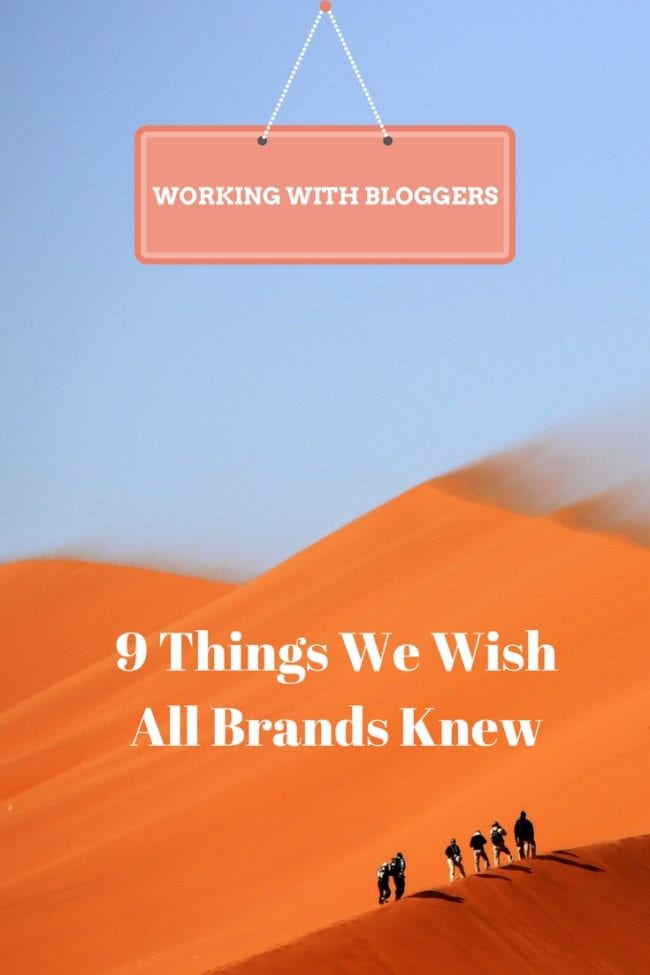Hi friends! I’ve been hard at work on my book but I thought I’d take a quick break to share something that’s been on my mind for a while. As both a publicist representing brands who hire influencers and a blogger/influencer who frequently partners with brands and destinations myself, I am dismayed that there’s still so much confusion about how to work together successfully. It’s been a little while since I’ve tackled a topic like this, so I hope you enjoy this little primer for the brand manager, publicist or marketing guru tasked with working with influencers to promote their products or destinations.
Blogger. Content Creator. Digital Influencer. Instagrammer.
What’s the difference? I use the terms interchangeably though there are plenty of differences. Many bloggers are influencers; not all influencers are bloggers. Some influencers are just big on Instagram, others are multi-platform superstars. There are more combinations of niches and communication vehicles than you can shake a stick at; way too many to unpack in one blog post. For now, I’ll just use the terms interchangeably, with the understanding that there are differences to account for when working with influencers of varying types.
Please note: I’ve intentionally left out discussion of the ethics of compensated content creation in the digital era. I’m well aware of the arguments for and against it, and there and many other places to discuss. If you’d like, I can make that the topic of a future post and we can hash it out there =)
1. This is My Living.
Think for a moment about your favorite travel magazine. The magazine has a staff dedicated to assigning, researching, writing, editing and publishing content. There’s probably an advertising sales department, too. Those employees make a living from the magazine, and are paid at regular intervals. When a staff writer is invited on a press trip, she is paid by the magazine for her time, for the content, the research, the photographs, etc.
For bloggers, the revenue mechanism is totally different. I am the whole staff at AngieAway.com. I do the travel, photography, research, writing, editing, publishing, distribution, social media, accounting & taxes, conferences, advertising.
I am the boss. This is my profession.
The revenue model is me, on my own, creating content and finding ways to monetize it. When you reach out to an influencer about a partnership and they *gasp* require payment for services, that’s why. This isn’t a hobby.
2. People Die of Exposure.
You know how you can’t imagine how those people in that other political party believe what they believe? That’s how I feel when a brand asks to pay me for a week’s worth of work in exposure. It’s especially hilarious when they have fewer social media followers than I do. Do they really think that’s a win for a self-employed writer?
Frankly, if a brand has the budget to pay the publicist or marketer to contact me in order to form a “partnership,” there ought to be plenty of budget to pay me for the content creation.

Getting a proposal to pay me in exposure derails my entire day, and I wrestle internally with how to respond. Should I just delete it? Respond snarkily with a GIF? (I just love GIFs, don’t you?) Send back a thoughtful response educating them on the importance of paying for professional work? Nah, I just write about it. Read my original rant on Why I Won’t Work for Free (And You Shouldn’t Either).
3. Know your Marketing Goal and Budget Before You Reach Out.
I recently received an email from a destination’s marketing firm asking if I’d like to do an Instagram takeover. In the intro letter, they offered fair compensation and all the details I’d need – deadline, terms, number of photos required – to make an informed decision. We came to an agreement in less than 4 communiqués. It was magnificent… and rare.
Much more often, I get emails from brands requesting to “partner” with me. Only after dozens of emails, or worse “hopping” on a call, does it become clear that there is no budget and the “partnership” they’re pitching is me writing stories on my site, Tweeting and Instagramming about them — without compensation. I fail to see the part where I benefit. (And no, sending me a $12 bottle of sunscreen to try out doesn’t count as payment.)
I know it can be tricky to connect with the multi-slash content creators – those folks who, like me, are freelance journalists / TV talking heads / bloggers / digital influencers / future best-selling novelists, etc., with multiple business models and revenue streams. There are many ways to work with us, so knowing what exactly you’re asking for up front helps everyone. Professional content creators should have a media kit, a Work with Me page or some resource where they outline how they work with brands. It shouldn’t be hard to find, and it’ll help you make sure you’re reaching out to the right person about the right opportunity, and ultimately working with influencers that will be a win for your brand.
4. There’s a Big Difference Between Press Trips and Influencer Campaigns.
When inviting a blogger on a regular old group press trip, you’re welcoming her to experience your destination for the chance that she’ll cover it editorially in the future. Perhaps she’ll write about it for her blog (which she may monetize), and she can pitch the story to publications that will pay her for the content. There are no guarantees that she’ll be able to place or profit from the story, so it can be a risk for both the destination and the writer. However, it only makes sense that a professional blogger will make every attempt to cover the destination. Her time is too valuable to waste on trips she doesn’t intend to write about. (This is one way to tell a pro from an amateur!)
If you invite a blogger to participate in an influencer campaign, you’re expecting guaranteed deliverables like a certain number of social media posts, photography, stories for her site and yours, etc. with a deadline. That guaranteed coverage (barring unforeseen circumstances or a truly terrible experience) is why it becomes necessary to pay the influencer. She’s committing coverage, time and resources to promote your brand. There’s no guarantee it will be all glowing coverage – no matter what, the FTC requires honesty and disclosure, but chances are if you have provided an interesting experience, everyone will be happy.
5. Influencer Campaigns/Press Trips Are Not a Vacation.
Explaining this concept to anyone who doesn’t travel for a living is a challenge, so please know that nothing I say is meant as a complaint. I love what I do, and it’s far better than any office job I’ve ever had. But work travel, even when it’s to a fabulous place, it’s anything but a vacation.
This is particularly true for pro travel influencers for whom travel is the job and staying home is the vacation. Newbie travel bloggers, mommy bloggers, tech writers, etc. might feel a little different about a cool trip. Know your audience!
As a multi-platform influencer, it’s my job to show off all the fun you can have in a destination. On social media, that probably looks like a pretty easy gig. Just fly somewhere and sit by the pool with a daiquiri, right? It’s a bit more complicated, believe it or not!
First, for me to travel for a 3-day campaign, it takes weeks, if not months, of preparation. Emails, phone calls, itineraries, booking questions – there’s mucho work on the front end to make sure everything goes smoothly during those three days. Once onsite, I’m capturing content, meeting clients and business owners, taking thousands of photos, shooting video for YouTube, Instagram and SnapChat, writing and posting to social media constantly — while losing my luggage, dropping my camera, getting sick and trying to call home to see if my husband is surviving on his own… OY!
Due to jam-packed scheduling onsite, I usually don’t have extra time to work on other projects, so I am not making money during that time.*
I go home, and the real work begins. Writing posts and content about the destination, editing photos and scheduling everything for distribution and promotion. It’s surprising how much there is to do! A 3-day trip, roughly 72 hours of travel, takes me at least another 20-40 hours of work including content creation, editing, invoicing, back-and-forth with the client, etc. Who knew there was so much involved in those little influencer trips!? They can be so much fun, but they are hardly a relaxing vacation.
*This is why it is not uncommon for a destination to provide a stipend or day rate, especially on long trips.
6. Influencers Can’t Live on Free Stuff.
An enormous international hotel chain once asked me to participate in an influencer campaign. The ask? Drive my car to their out-of-state hotel, stay there for two nights, attend all scheduled events, photograph the property, share updates live on social media. Upon returning home, create stories about the trip for my site and theirs.
When I asked the budget, they responded,
“We can offer 2 nights at our brand new resort valued at approximately $450. In addition to covering the stay, we would also provide a $200 payment.”
Realistically, it would cost me $200 in food and gas just to participate in the campaign, so that cash would be gone. And the $450 hotel stay…well, I can’t pay the electric bill with the value of a hotel stay.
For roughly 80 hours of travel time, onsite work and writing afterward, I would net exactly zero dollars after expenses. Perhaps this explains why I say no much more frequently than I say yes! This shows me a brand who doesn’t grasp the basics of working with influencers.
Can you imagine if your boss said, “Hey, we need you to fly to Cincinnati for a few meetings and a presentation next week. You actually won’t get paid for the time you spend preparing, the work you do while there or the wrap-up report when you get home, but you do get two free nights at the airport hotel and a coach class seat with only two layovers!” A normal, salaried worker wouldn’t go for that, and influencers can’t either.
Because travel itself is so wonderful, travel brands and destinations offer free rooms as payment often. Of course, comped rooms are always going to be a part of the travel content creator / brand relationship, but never in lieu of fair payment for actual services and deliverables.
Hear me: if travel is required to do the job, it cannot also count as payment for the job.
Related: If an influencer reaches out about writing a story about your hotel, and you offer a media rate, make sure it isn’t the same rate available on the Internet to everyone in the world. No blogger wants to pay full price and still have to work for the privilege. It’s insulting and we don’t like it, ok?
7. Vet Your Influencers Well.
How many times have we seen it happen? A huge travel brand hires a pack of “influencers” for a campaign, shelling out tens of thousands of dollars for access to their zillions of fans. But wait…. the emperor is butt naked, and the influencer isn’t what he claims to be.
Did you know you can start an Instagram account today, pay $55 and have 10,000 followers by tomorrow? That’s bananas. And it’s so embarrassing for the brand when the influencer *gasp* doesn’t deliver amazing content.
If you owned a company, would you want to pay an Instagrammer $20,000 to promote your product if you knew that the majority of their followers were bots? Ya know, fake people? I know I wouldn’t. But brands do it every day.
Working with influencers is not about throwing money at the bloggers, Tweeters or Instagrammers with the most followers. There’s so much more to it than that! Relevance, interaction, engagement, fit with your brand… if you’re just looking at numbers, you’re not going to be happy with the ultimate results. The good news is there are plenty of easy ways to take a quick look at someone’s followers. Use those resources and hire the best influencers. It’s the only way influencer marketing works!
8. Influencers Really Want to Make You Happy.
The best influencers, the real pros, want to do an outstanding job for your brand or destination. Sure, we like to get paid, but we also want to kick a$$. It benefits us greatly to under-promise and over-deliver, so someday we can discuss turning this small campaign into a longstanding relationship. Help us do a great job. Communicate your expectations early and often. Send our itinerary as soon as you can. Give us packing tips. Share your goals so we can help meet them.
9. Do Whatever it Takes to Pay Content Creators ASAP.
Think of a blogger like a human being. Human beings need a few things to survive; food, water and shelter come to mind. To get those things, bloggers need paychecks. The worst part about being a freelancer, from any profession, is constantly having to chase them down.
We shouldn’t have to put out an APB to get the money you’ve promised to pay. Influencers are often living on a very thin margin (unless they’re in fashion and then they’re literally dressed in money), so every check counts. We thank you in advance for being cool about this.
Don’t think I forgot about my roots! Check out 13 Things Brands Want Bloggers to Know in 2017… oh yeah, I went there. Buckle up, I’m feeling sassy in 2017.
PIN ME



